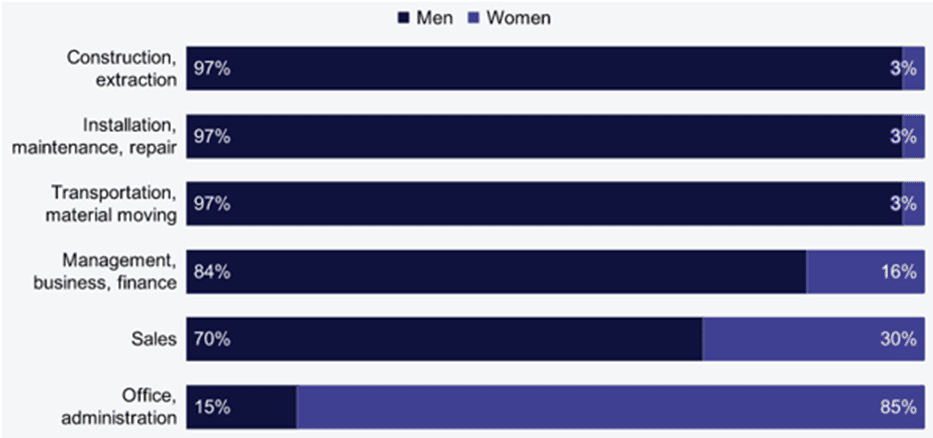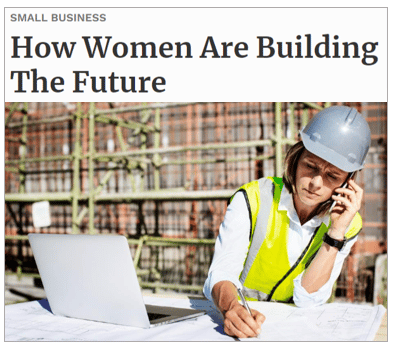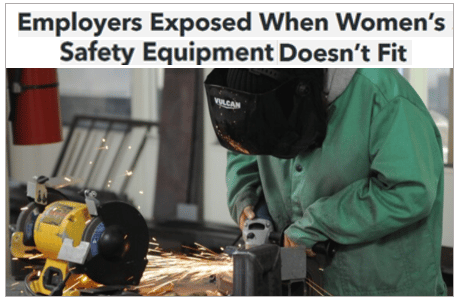If you’re under the impression that the construction industry has been and still is dominated by men, you would be right.
There are many reasons behind this historical and persisting gender imbalance, including the fact that many construction companies still have a (un)conscious bias against employing more women, while women still often perceive the construction industry in a negative light.
However, pressured by skilled labor shortages and motivated by social and technological advancements, the industry is quickly changing.
That’s why we’ll look at recent statistics about women in construction, the benefits they bring to construction companies, the challenges they face in their work, and the ways in which company owners, managers, and other employees can support them.
In this article...
What Statistics Show
So, what do statistics tell us about women in construction?
First, they show us that women have traditionally been and still are seriously underrepresented in the construction industry.
Namely, the U.S. Bureau of Labor Statistics (BLS) has revealed that women made up 10.9% of the construction workforce in 2021.
As the graph below shows, that percentage actually represents a 1.8% increase compared to 2017 (9.1%) and comes as a result of efforts to close this giant gender gap perpetuated by the industry in general and individual construction companies in particular.

However, considering that women (47%) and men (53%) are almost equally represented in the total number of employed people, it’s clear there is a long way to go in improving the share of female employees in the construction industry.
The second thing statistics show is that when women do work in construction, they don’t often work, e.g., as construction laborers (4.5%), carpenters (3.1%), or construction equipment operators (3.0%).
Overall, only 3.9% of all female employees in construction work in field occupations.
In other words, they’re most likely to work in office and administrative positions, as this graph of construction occupations by gender shows.

Moreover, along with being a minority in construction trade positions (3%), the above graph also shows women are underrepresented in management positions (16%).
Nevertheless, despite what the statistics show, there’s an industry-wide effort to attract, hire, and retain more women in construction occupations to at least narrow the long-standing gender gap.
How Women Benefit the Construction Industry
Hiring more women in construction helps companies address the labor shortage, improve their reputation, increase innovation, and drive productivity and profitability.
Worker shortage has long been plaguing the construction industry for many reasons.
When it comes to women, those reasons have a lot to do with perceiving the industry as a field dominated by men doing hard, dangerous, and often low-paid work.
And although that perception is often erroneous and depends on numerous other factors, it’s enough for many women to never even consider a career in construction.
But when companies focus on creating and promoting more opportunities for women (and other underrepresented groups like some minorities) and widen their hiring pool, it can help them fill the employment gap.
When the above-mentioned tactic is combined with company management committed to diversity, equity, and inclusion (DE&I, DEI) and appropriate policies against harassment and discrimination, it improves the company’s reputation and leads to even more job applications.

As hinted in the above image, women bring different perspectives, skills, and experiences that tend to promote innovation in construction.
According to the International Labor Organization (ILO) report, companies with inclusive business cultures and policies can expect a 59% increase in innovation.
However, to actually attract hidden talent and ideas, construction companies need to practice what they proclaim and value the individual and group differences within their workforce, which includes gender equality.
In other words, when a company’s working environment is inclusive and supportive, women (and all other employees) feel valued, which in turn increases their motivation, engagement, creativity, and innovation.
Naturally, all of this boosts productivity and leads to higher profitability.
To quote a Forbes article on women’s role in construction:
Companies with a higher percentage of women tend to be more profitable, and having more women tends to increase a company’s innovative potential.

Put simply, the more women a construction company employs, the more likely it is it will financially outperform its competitors with predominantly male workers.
Thus, hiring, supporting, and promoting more women can help individual companies and the construction industry in general deal with the labor shortage, improve their image, enhance their innovative potential, and increase their overall productivity and profitability.
Challenges Women Face in Construction
Despite industry-wide initiatives and efforts undertaken by companies to become more gender-diverse and inclusive, women still face many barriers that often discourage them from working in construction.
We’ll first look at the issue of the lack of respect and sexual harassment women face from male workers, which can occur regardless of whether the women are working in the office or in the field.
The following two, unfit safety equipment and no female restrooms, refer primarily to women working in the field, i.e., on construction sites.
Lack of Respect for Women
As we’ve established, construction is a male-dominated industry, and, when left unchecked, such an environment can perpetuate harmful stereotypes of women, often portraying them as less competent at their job, not physically or mentally strong enough, needing the help of men, and so on.
As a result, women in construction can feel excluded, like their opinions are not valued, and like they have to work twice as hard as their male coworkers to earn respect.

Thus, although many companies have professed themselves to be equal opportunity employers regardless of gender, this perception of male dominance and lack of respect for women remains a barrier that stops many women from starting to work in construction or remaining in the field.
Sexual Harassment From Male Workers
Unfortunately, women in construction can and still do experience different inappropriate behaviors from their male colleague, the most egregious of which is outright sexual harassment.
Because men outnumber women in construction, this prevalent inappropriate behavior can make women feel unsafe at work.
For instance, Rio Tinto, the global mining corporation, commissioned an external study in which nearly 25% of its workforce shared their experiences and views about sexual harassment, bullying, and racism within the company.
The study found that almost 30% of women (and 7% of men) have experienced sexual harassment at work.
Even more worrying was that 21 women reported actual or attempted rape or sexual assault, as Reuters reports.

This and similar reports indicate to women that the likelihood of sexism and sexual harassment from male coworkers is still high in the construction industry, thus discouraging them from joining or staying in construction.
Safety Equipment Unfit for Women
When women are working in construction trades or are otherwise present on construction sites (in the capacity of a supervisor, manager, etc.), another challenge they face is that safety equipment is often unfit for women.
That’s the result of construction being dominated by men for so long that standard personal protective equipment (PPE) is made with an average man in mind, as explained in a Bloomberg Law article.

Looking at the image more closely shows why ill-fitting PPE poses a range of safety risks for women (and men) with smaller body frames.
To use a quote from the article made by Abby Ferry, a workplace safety expert and advocate:
Many (women) are forced to wear ill-fitting harnesses, hard hats, fall protection, and gloves.
Of course, wearing safety gear tailored for men hinders women in their work and endangers their safety on the construction site.
And reduced safety can certainly be one of the factors why women change jobs or never even take a job in construction.
Lack of Female Restrooms
Compared to the three previous challenges that directly affect women’s dignity, as well as their mental and physical safety, the absence of female restrooms on construction sites may seem insignificant.
However, the availability and cleanliness of sanitary facilities, whether unisex or gender-specific, are a significant concern for women in construction, with as many as 80% of them encountering jobsites with dirty toilets or none at all.
So, this is an everyday challenge for many women working on construction sites, which may prompt them to change jobs and can discourage potential new female hires.
The issue stems from the fact that although portable restrooms are common on construction sites, few of them are designed with women in mind.
Often, single-occupant portable toilets are too small to accommodate women and their hygienic needs.
Furthermore, on-site restrooms are usually not gender-specific, i.e., they are used by both men and women, so female employees can be wary of using them for reasons other than just sanitary conditions.
Consequently, the lack of appropriate restrooms is a serious challenge for current and potential female workers on construction sites.
Overall, these four challenges represent some barriers that prevent women from entering and staying in the construction industry, which brings us to the question of what companies can do to overcome them.
How Construction Companies Can Support Women
In this section, we’ll focus on what companies can do to attract and retain women in construction.
We’ll discuss four methods: creating an inclusive recruitment process to attract more female applicants, taking measures to prevent workplace harassment, providing necessary resources, and offering advancement opportunities to women.
Create an Inclusive Recruitment Process
The first thing companies can do to show support for women in construction is to establish inclusive recruitment practices.
That starts with the job description that a company provides when posting vacancies on their website and other job posting sites like LinkedIn or the more specialized ConstructionJobs.

As job descriptions are often the first point of contact between the company and potential new employees, they should use gender-neutral pronouns and be aware of other language that could alienate women.
In their job descriptions and branding in general, construction companies should also emphasize their commitment to inclusion and diversity and highlight benefits they offer women, such as maternity or child-care leave.
Naturally, companies should strive to eliminate any gender (and other) biases in their recruitment process and hire workers based on their qualifications, skills, and talents.
Take Measures to Prevent Workplace Harassment
Naturally, if a construction company wants to attract and keep its female employees, it must make them feel safer by taking measures to prevent workplace harassment.
This should start with companies establishing and enforcing zero-tolerance policies aimed at protecting women from any kind of workplace harassment, bullying, and discrimination.
Then, companies should organize harassment prevention training for their employees, including all levels of management, and/or find other ways to clearly communicate what behaviors and actions will not be tolerated, as suggested in an article by Lawley.

After that, companies should practice what they preach and swiftly act on all reports of workplace harassment.
Otherwise, if reported incidents of workplace harassment are ignored, brushed off, or downplayed, companies are indirectly endorsing harmful behavior and making female employees feel unsafe, thus forcing them to leave.
Provide Women With Appropriate Resources
Next up, construction companies should provide their female employees with the appropriate resources to make working conditions better for women.
Broadly defined, such resources include the already mentioned inclusive recruitment practices, anti-harassment policies and training, as well as ensuring that women have equal pay and opportunities as their male colleagues, and also some specific benefits like maternity leave.
On construction sites, appropriate resources can mean ensuring that women have access to suitable restrooms and personal protective equipment fitting their size.

Finally, providing women with appropriate resources also means enabling them to advance their career and professional development within the company, as we will discuss below.
Offer Advancement Opportunities to Women
Regarding advancement opportunities, women in construction generally want the same things as men, namely a good salary and benefits, along with opportunities to further their career and professional development.
Naturally, women should be offered the same opportunities as their male coworkers to, for example, get a promotion, pay raise, or bonus, or to participate in different education and training programs for professional development.
When a construction company does that, it can expect a much higher retention rate among its female employees and a better launching ground for their future recruitment.
According to Wendy Zang, recruitment consultant at Helbling & Associates, women tend to stay with companies where they’re given the same opportunities as men, concluding that:
In short, construction and engineering employers can entice women as employees and keep them happy if they treat them as equals.
Therefore, construction companies should eliminate gender bias, treat their male and female workers equally, and promote them based on merit.
Conclusion
So, we’ve looked at some statistics, benefits, and challenges related to women in the construction industry and followed that up with advice for companies that want to support their existing and future female employees.
The main takeaway?
Construction companies can do a lot to change negative stereotypes of women in their workforce and make their workplace culture more inclusive and receptive to women, thus attracting and retaining more female employees and improving the industry’s reputation.





